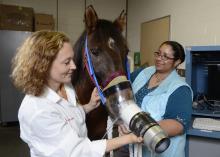Information Possibly Outdated
The information presented on this page was originally released on May 31, 2012. It may not be outdated, but please search our site for more current information. If you plan to quote or reference this information in a publication, please check with the Extension specialist or author before proceeding.
CVM research aims to fast-track discoveries
MISSISSIPPI STATE – New medical breakthroughs offer hope to those who suffer from health problems, and researchers at Mississippi State University are trying to reduce the time it takes for scientific advances to get from the laboratory to the patient.
At MSU’s College of Veterinary Medicine, basic science researchers and veterinary clinicians are working together to investigate common diseases, processes and functions with the goal of improving the health of both animal and human patients. These unique research projects involving animal and human diseases have been brought together in the Translational Biomedical Research center, established in 2011.
“CVM’s professionals are uniquely qualified in translational medicine because it involves using animal models to develop safe and effective treatments that can be applied, or translated, to human medicine,” said Dr. Mark Lawrence, CVM associate dean for research and graduate studies. “On average, there is a lag of 10 years between basic scientific research findings and the benefit to patients. Translational research shortens that to 2 to 3 years on average.”
Within the CVM, conditions seen in the clinic can be studied in the lab, and potential solutions can be tested efficiently. Ultimately, effective findings will be “translated” from their veterinary applications to human uses.
One such study represents more than 20 years of clinical practice and observation in horses.
“I started looking at summer pasture-associated obstructive pulmonary disease in horses in the late ’80s and early ’90s,” said Dr. Cyprianna Swiderski, CVM associate professor of equine medicine. “Many of us who work with it said, ‘This is so much like human asthma.’”
She said at that time, it was believed the cells responsible for asthma in humans and the similar disease in horses were different types of cells. Now researchers have discovered similarities in the diseases at the cellular level, which means Swiderski’s research on equine patients may be more applicable to human patients than previously thought.
“This particular translational model is coming of age,” she said.
Swiderski is collaborating with a pioneer in the field, Richard Bond, a professor of pharmacology at the University of Houston. They are investigating a novel and noninvasive approach to asthma therapy in horses. This work builds upon Bond’s investigations in both mouse models and mild human asthma.
“Obviously I care deeply for the health of each of my patients, but at this stage in my life, I’m intrigued by things that have a greater impact, and making contributions that advance medicine,” Swiderski said. “It’s exciting to think about improving the quality of life for many animals and people, to think of medicine as more than just one patient at a time.”
For human and animal patients, getting research findings “from the bench to the bedside” is an urgent need. This urgency is reflected in national initiatives to develop innovative methods and technologies designed to reduce, remove or bypass bottlenecks in delivering new drugs, diagnostics and medical devices to patients with a wide range of diseases and conditions.
“Translational research can bridge an enormous gap between basic science and applied science,” said Dr. Andrew Mackin, small animal medicine service chief and Hugh G. Ward Endowed Chair of Small Animal Veterinary Medicine at the CVM.
“Applied science research is need-driven, has a quick turnaround, and helps patients. The research questions are applied, not theoretical. Translational biomedical research ties the two together,” he said.
Current research projects at the Translational Biomedical Research center range from studies of asthma and diabetes to wound healing. Such problems occur naturally in many animals, including horses, dogs, pigs and cats.



